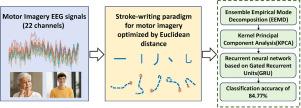Design and implementation of a writing-stroke motor imagery paradigm for multi-character EEG classification
IF 2.8
3区 医学
Q2 NEUROSCIENCES
引用次数: 0
Abstract
Motor imagery (MI) based brain–computer interfaces (BCI) decode neural activity to generate command outputs. However, the limited number of distinguishable commands in traditional MI-BCI systems restricts practical applications. To overcome this limitation, we propose a multi-character classification framework based on Electroencephalography (EEG) signals. A structurally simplified MI paradigm for stroke writing is designed, and maximize Euclidean distance trajectory optimization enhances neural separability among five stroke categories. The EEG data cover 11 motor imagery tasks, including five stroke-writing tasks and six related movement tasks such as hand, foot, tongue movements and eye blinks, collected from ten participants. Ensemble Empirical Mode Decomposition (EEMD) eliminates artifact-related Intrinsic Mode Functions (IMFs) and reconstructs the signals. Kernel Principal Component Analysis (KPCA) then conducts nonlinear dimensionality reduction to extract discriminative features. Finally, a recurrent neural network based on Gated Recurrent Units (GRU) performs classification, effectively modeling the temporal dynamics of EEG signals. Experimental results indicate that the optimized stroke paradigm achieves an average classification accuracy of 84.77%, outperforming the unoptimized version at 76.83%. Compared to existing MI-BCI methods, the proposed framework improves classification accuracy and expands the set of distinguishable commands, demonstrating enhanced practicality and effectiveness.

多字脑电分类笔画运动意象范式的设计与实现。
基于运动意象(MI)的脑机接口(BCI)解码神经活动以生成命令输出。然而,传统MI-BCI系统中可识别命令的数量有限,限制了实际应用。为了克服这一限制,我们提出了一种基于脑电图信号的多字符分类框架。设计了一种结构简化的笔划书写MI范式,最大欧几里得距离轨迹优化增强了五种笔划类别之间的神经可分性。脑电图数据涵盖了11项运动想象任务,包括5项笔划书写任务和6项相关运动任务,如手、脚、舌头运动和眨眼,这些数据来自10名参与者。集成经验模态分解(EEMD)消除伪影相关的内禀模态函数(IMFs)并重建信号。然后核主成分分析(KPCA)进行非线性降维提取判别特征。最后,基于门控递归单元(GRU)的递归神经网络进行分类,有效地模拟了脑电信号的时间动态。实验结果表明,优化后的笔画范式平均分类准确率为84.77%,优于未优化版本的76.83%。与现有的MI-BCI方法相比,该框架提高了分类精度,扩展了可区分命令集,增强了实用性和有效性。
本文章由计算机程序翻译,如有差异,请以英文原文为准。
求助全文
约1分钟内获得全文
求助全文
来源期刊

Neuroscience
医学-神经科学
CiteScore
6.20
自引率
0.00%
发文量
394
审稿时长
52 days
期刊介绍:
Neuroscience publishes papers describing the results of original research on any aspect of the scientific study of the nervous system. Any paper, however short, will be considered for publication provided that it reports significant, new and carefully confirmed findings with full experimental details.
 求助内容:
求助内容: 应助结果提醒方式:
应助结果提醒方式:


